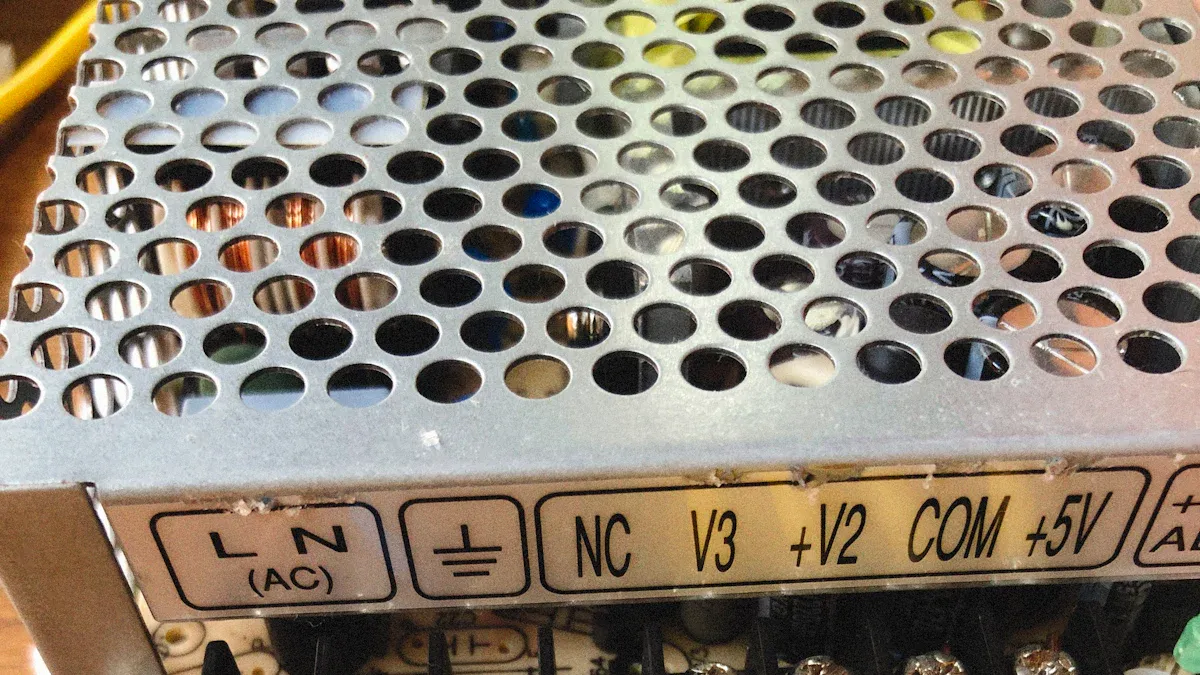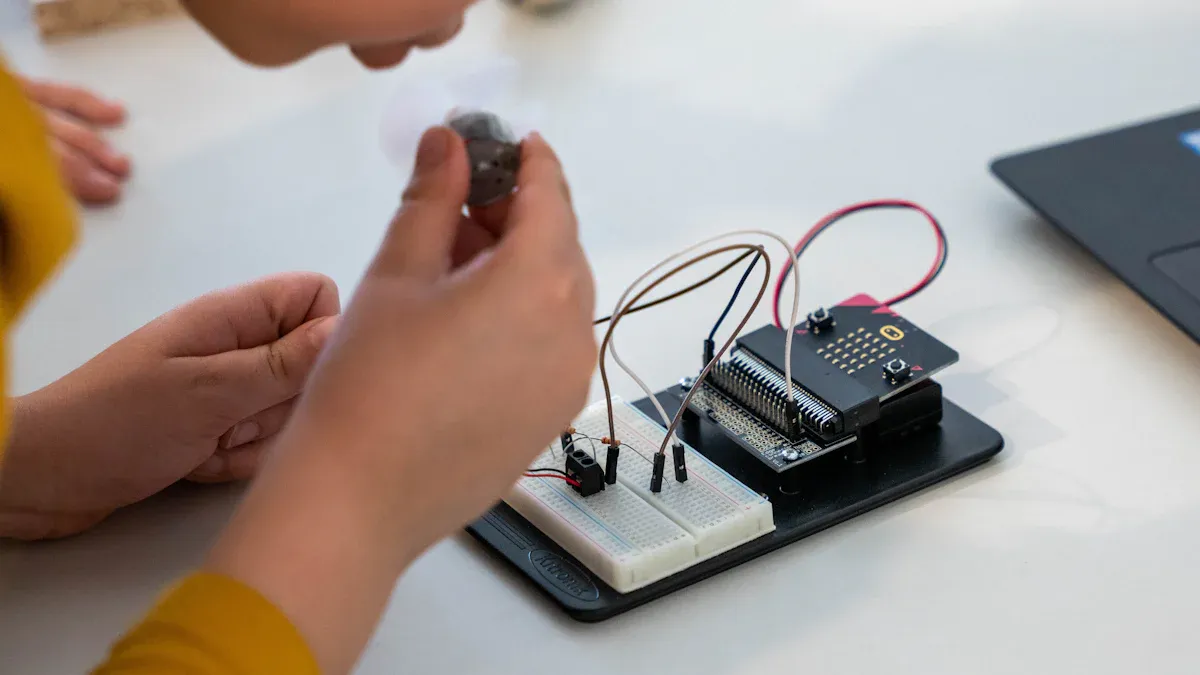How to Build a Variable Power Supply with the LM317

Building a variable power supply is an essential skill for anyone interested in electronics. This project allows you to adjust voltage levels for various applications. The global programmable DC power supply market is projected to grow at a compound annual growth rate of approximately 4.82%, highlighting the increasing need for such devices in electronics testing and production. By using the LM317 voltage regulator, you can create a reliable and versatile power supply for your projects.
Key Takeaways
The LM317 voltage regulator lets you adjust output voltage from about 1.2V to 37V, making it useful for many electronics projects.
Two resistors or a resistor and a potentiometer set the output voltage easily using a simple formula.
Capacitors and a heatsink are important to keep the power supply stable and prevent overheating during use.
Following proper wiring, component placement, and safety steps ensures a reliable and safe power supply build.
Testing and troubleshooting common issues like wiring errors or voltage ripple help maintain steady and accurate output.
Components

LM317 Voltage Regulator
The LM317 is a versatile voltage regulator that allows you to adjust the output voltage from 1.25V to 37V. This adjustable linear voltage regulator can supply up to 1.5A of current, making it suitable for various applications. The LM317 operates by dissipating excess voltage as heat, which means you must manage thermal conditions effectively. It includes built-in protections like current limiting and thermal shutdown, enhancing its reliability.
Here’s a quick overview of the LM317's specifications:
Specification | Description |
|---|---|
Output Voltage Range | |
Maximum Output Current | 1.5 A |
Package Type | TO-220 |
Built-in Protections | Overheating and current overload protection |
Capacitors and Resistors
Capacitors and resistors play crucial roles in stabilizing and adjusting the output of the LM317 circuit. Here’s a breakdown of their functions:
Input Capacitor: This capacitor filters the input voltage and reduces noise. A typical value is between 0.1µF and 1µF. It stabilizes the input voltage and prevents oscillations, ensuring smooth operation.
Output Capacitor: This component smooths the output voltage ripple and improves transient response. A larger capacitor, such as 100µF, is often used to maintain a steady output voltage during load changes.
Resistors (R1 and R2): These resistors form a voltage divider that sets the output voltage. The formula for calculating the output voltage is:
Vout = 1.25 × (1 + R2/R1)Typically, R1 is set to 220Ω to 240Ω, while R2 is calculated based on the desired output voltage. You can also use a potentiometer in place of R2 for variable voltage adjustment.
Heatsink: Although not a resistor or capacitor, a heatsink is essential for dissipating heat generated by the LM317. Proper thermal management prevents overheating and ensures stable operation.
Here’s a summary of the essential components and their roles:
Component | Role/Description |
|---|---|
LM317T regulator | Adjustable voltage regulator capable of supplying up to 1.5A. Requires input voltage at least 2.5V higher than output. |
Resistors (R1, R2) | Set output voltage based on LM317's 1.25V reference voltage. R1 typically 220-240Ω; R2 calculated based on desired output voltage. |
Input Capacitor | Stabilizes input voltage and reduces noise. Typically 0.1µF to 1µF. |
Output Capacitor | Smooths output voltage ripple and improves transient response. Commonly 100µF. |
Heatsink | Dissipates heat generated by the LM317 regulator. Necessary for proper operation. |
Ammeter & Voltmeter | Optional for monitoring output current and voltage. Provides visual feedback on power supply performance. |
Fuse | Optional for protection against short circuits. Fast-acting fuse recommended. |
Choosing high-quality components is vital for the longevity and reliability of your LM317 power supply. Proper thermal management and component selection will ensure stable operation and minimize the risk of failure.
Circuit Design

Schematic Overview
The schematic for the LM317 variable power supply is straightforward yet effective. It includes the LM317 voltage regulator, resistors, capacitors, and optional components like transistors for higher current loads. The LM317 allows you to adjust the output voltage using a voltage divider formed by resistors. The formula for calculating the output voltage is:
Vout = Vref × (1 + Rp/R1)
Here, Vref is 1.25V, and Rp is the resistance from the potentiometer combined with R2. This setup ensures voltage adjustability from approximately 1.25V to over 32V. The LM317 also features built-in protections, such as current limiting and thermal overload protection, to safeguard your circuit. To enhance protection, you can add two 1N4007 diodes in reverse to prevent damage from incorrect high voltage supply.
Connection Details
Proper connections are crucial for the stability and safety of your LM317 circuit. Follow these best practices:
Connect the input voltage to the IN pin. Ensure it is at least 3V higher than your desired output voltage.
Attach the output load to the OUT pin.
Use a resistor (typically 240 ohms) between the OUT pin and the ADJ pin. Connect a second resistor from the ADJ pin to ground to set the output voltage accurately.
Place capacitors on the input (around 0.1µF) and output (around 1µF) pins to improve stability and reduce ripple.
Ensure adequate heat sinking to prevent the LM317 from overheating, especially when outputting higher currents.
Double-check the polarity and soldering quality to maintain circuit reliability.
By keeping input and output traces short, you reduce resistance and inductance, which improves stability. Place decoupling capacitors close to the LM317 pins to minimize noise. Following these guidelines will help you create a robust and reliable variable power supply.
Assembly Instructions
Preparing Components
Before you start assembling your LM317 variable power supply, gather all necessary components and tools. Follow these steps to prepare effectively:
Mark and Drill Holes: Begin by marking and drilling holes in your enclosure for major components. This includes the transformer, PCB mounting points, voltage adjustment knob, fuse holder, AC input socket, DC output terminals, and ground terminal.
Mount the Transformer: Install the transformer into the enclosure first. After that, secure the PCB assembly and other parts like the fuse holder, output connectors, ground connector, potentiometer, and AC plug connector.
Wire the Components: Connect the components according to the schematic. Start from the AC input side and move towards the DC output side. Ensure correct polarity and secure insulation for all AC connections.
Connect the Transformer: Attach the transformer’s two outer wires to the AC inputs of the bridge rectifier on the PCB. Connect the center tap to the dedicated terminal in the enclosure. Make sure to establish proper grounding between the PCB assembly and the metal enclosure.
Label Key Areas: Clearly label important areas of the power supply, such as the DC output and adjustable knob. This will help ensure safe usage and ease of operation or servicing.
Assembling the Circuit
Now that you have prepared your components, follow these steps to assemble the circuit:
Select a Transformer: Choose a transformer that steps down AC 220V to around 24V AC, or another suitable voltage based on your desired output.
Use a Bridge Diode Rectifier: Connect four 1N4001 diodes to convert AC to DC. This step is crucial for ensuring your LM317 receives the correct input voltage.
Smooth the Rectified DC Voltage: Add a large filter capacitor, such as a 1000µF electrolytic capacitor, to reduce ripple in the DC voltage.
Connect the LM317: Attach the LM317 adjustable voltage regulator IC to the filtered DC input. This component is key to achieving variable output voltage.
Add Resistors: Connect a potentiometer (typically 5K or 10K) and a fixed resistor (around 220Ω) to the LM317's adjustment pin. This setup allows you to set the output voltage according to the formula:
Vout = 1.25 × (1 + Rp/R1)Include Protection Diodes: Add protection diodes, such as 1N4007, to prevent reverse voltage damage to the LM317.
Install Additional Capacitors: Place capacitors (e.g., 0.1µF ceramic and 470µF electrolytic) near the LM317 for improved filtering and stability.
Mount Components: Secure all components on a PCB or universal board. Ensure correct polarity and secure soldering to avoid future issues.
Use a Heat Sink: Attach a suitable heat sink to the LM317 to manage temperature during operation. This step is vital for preventing overheating.
Test the Power Supply: After assembly, test the power supply by adjusting the potentiometer and measuring the output voltage. Ensure it ranges from about 1.25V up to the maximum allowed by the transformer and LM317 input voltage limits.
Optional LED Voltmeter: For real-time voltage monitoring, consider adding an LED voltmeter display.
By following these steps, you can successfully assemble your LM317 variable power supply. Remember to take safety precautions throughout the process.
Safety Tips
Always use personal protective equipment (PPE) such as gloves and safety glasses.
Ensure power is disconnected before working on devices. Physically unplug devices rather than just switching them off.
Use insulated and non-conductive tools.
Avoid contact with live wires, especially with wet or bare hands.
Maintain a clean and organized workspace.
Following these guidelines will help you create a reliable and safe variable power supply.
Troubleshooting
Common Issues
When building your LM317 variable power supply, you may encounter several common issues. Here are some frequent problems you might face:
Insufficient Input Voltage Filtering: If you notice large voltage ripples, your input voltage filtering may be inadequate. A large reservoir capacitor, typically in the thousands of microfarads per amp, can help maintain stable voltage.
Wiring Errors: Incorrect pin connections often lead to malfunctions. Double-check your wiring against the schematic to ensure accuracy.
Exceeding Maximum Input Voltage: The LM317 has a maximum input voltage rating of 40V. If your transformer’s secondary voltage peaks exceed this, you risk damaging the regulator.
Load Conditions: Ensure that your load conditions and input voltage levels are appropriate. Improper load can lead to instability.
Current Measurement Mistakes: If you connect your multimeter incorrectly while measuring current, it can short the output. This mistake can cause overload trips.
Solutions
To resolve these issues, follow these troubleshooting steps:
Check Capacitors: Ensure your output capacitors are within the recommended values and ESR ranges. Place them close to the LM317 to prevent oscillations.
Test with a Resistor Load: Use a simple resistor load (100 to 1000 ohms) to rule out load-supply interactions causing instability.
Monitor Temperature: Watch for temperature-induced voltage drift. The internal reference voltage of the LM317 can shift with temperature changes.
Verify Wiring: Confirm that the adjustment pin and potentiometer are wired correctly. Ensure the potentiometer is not connected as a two-terminal variable resistor.
Use Proper Heat Sinking: Ensure you have adequate heat sinking. Without it, the LM317 can reach dangerous temperatures, risking failure.
Consult the Datasheet: Always refer to the LM317 datasheet for specifications on capacitors and temperature coefficients. This resource can guide you in maintaining stability.
By following these troubleshooting tips, you can effectively diagnose and fix issues with your LM317 variable power supply. Remember, careful assembly and attention to detail will help you avoid many common problems.
Building a variable power supply with the LM317 offers you a practical way to learn about electronics. You gain hands-on experience with essential components like resistors, capacitors, and the LM317 itself. Here are some key takeaways:
The LM317 provides an adjustable output voltage range from 1.2V to 37V, making it versatile for various applications.
You only need two external resistors to set the output voltage, simplifying the design.
While LM317-based supplies may not match commercial lab power supplies in performance, they are cost-effective for basic experiments.
By following the assembly instructions and safety precautions, you can create a reliable power supply that enhances your understanding of electronic circuits. Enjoy your journey into the world of electronics!
FAQ
What is the LM317 used for?
The LM317 is a voltage regulator. You can use it to create a variable power supply that adjusts output voltage from 1.25V to 37V. This feature makes it ideal for various electronic projects.
How do I calculate the output voltage?
You can calculate the output voltage using this formula:
Vout = 1.25 × (1 + R2/R1)
Choose R1 as 240Ω and adjust R2 to set your desired voltage.
Do I need a heatsink for the LM317?
Yes, you need a heatsink. The LM317 generates heat during operation. A heatsink helps dissipate this heat, preventing overheating and ensuring stable performance.
Can I use a potentiometer instead of a resistor?
Absolutely! You can replace R2 with a potentiometer. This change allows you to adjust the output voltage easily, giving you more flexibility in your projects.
What should I do if the output voltage is unstable?
Check your connections and ensure all components are correctly placed. Also, verify that your capacitors are functioning properly. If issues persist, consider adding more filtering capacitors to stabilize the output.
See Also
Step-By-Step Guide To Creating Audio Power Amplifier Circuits
Mastering The Setup And Programming Of 555 Timer ICs
Understanding Three-Terminal Voltage Regulators And Their Functions
